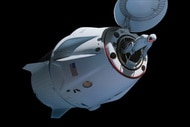Create a free profile to get unlimited access to exclusive videos, sweepstakes, and more!
Upcoming Euclid Mission Will Shine a Bright Light on Dark Matter & Energy
It's pretty dark out there.
In the 2020 science fiction thriller The Invisible Man (streaming now on Peacock!), optical engineer and inventor Adrian Griffin (Oliver Jackson-Cohen) uses cutting edge optical technology to build a suit which renders the wearer invisible. After his supposed death, Griffin’s partner, Cecilia (Elisabeth Moss), learns just how effective the suit is, when he uses it to torment her from beyond the grave.
Knowing there is something out there, acting on your environment in ways you can’t see or understand, is a special kind of terror. And it’s a terror we all have to live with, thanks to the existence of dark matter and dark energy. All of the stuff we’ve ever seen, every gorgeous image of a galaxy, nebula, or supernova ever captured by Hubble or the JWST, makes up only about 5% of the actual stuff in the universe. The rest of it is dark matter and dark energy, which remain almost wholly mysterious. Scientists are hoping to change that with the launch of the Euclid spacecraft.
Euclid’s Mission to Reveal the Dark Universe
Roughly 25% of the stuff in the universe is invisible matter which exerts a gravitational influence but doesn’t otherwise interact. We can’t see it with our telescopes or sniff it out with our other astronomical instruments. We don’t really know what it is or how it works, but we know it must be there. As a result, it has earned the moniker of dark matter. The rest of the universe, roughly 70% of what’s out there, is dark energy. It’s equally mysterious and is believed to have a role in the ongoing expansion of the universe.
RELATED: Dark Matter May Have Come From a Second, Darker Big Bang
Understanding the origin, characteristics, and role of dark matter and dark energy is one of the biggest challenges in modern astronomy, and Euclid plans to tackle it head on. The spacecraft is a collaboration between the European Space Agency (ESA) and the Euclid Consortium, a group of more than 2,600 people from laboratories and organizations all over the world. It includes participants from 14 European nations, as well as Japan, Canada, and the United States.
Over its several-year mission, Euclid will create the largest and most accurate 3D map of the universe ever made. It will build its map with two onboard instruments: the visible-wavelength camera (VIS) and the Near-Infrared Spectrometer and Photometer (NISP).
The NISP instrument will measure the brightness and intensity of light from billions of galaxies across a distance of 10 billion light-years. The map will cover roughly a third of the sky, focusing on areas not dominated by the Milky Way to get the best view of distant objects. NISP will then calculate the redshift and true distance of those galaxies to create a map of the universe across both space and time. By covering the last 10 billion years of the universe’s evolution in precise detail, astronomers hope to reveal the role of dark energy in the expansion of the universe.
Meanwhile, the VIS camera will measure the shape of the same galaxies looking for irregularities. Distortions in spacetime revealed as lensing events around galaxies will reveal the distribution of dark matter throughout the cosmos. The combined data from both instruments will result in the most detailed map of the universe to date, and hopefully shine a light onto the mysteries of dark matter and dark energy in the process.
RELATED: Dark matter planets might exist, and we have ways to find them
At the time of writing, Euclid has been fueled with hydrazine and gaseous nitrogen, in preparation for launch. Once in orbit at Earth’s L2 Lagrange point, six cold gas micro-propulsion thrusters will use the onboard fuel to make the minute adjustments necessary to return clear images. When the mission is over, the last of the fuel will kick Euclid into the cosmic trash heap.
Launch of the Euclid spacecraft is scheduled for July 1, 2023, with a backup launch date the following day.
Invisible things might be horrifying, but they’re certainly interesting. Catch The Invisible Man, streaming now on Peacock!
































